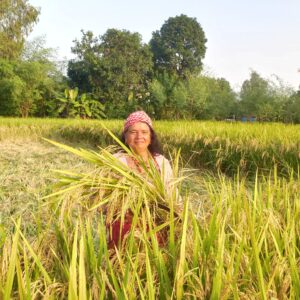Animal-sourced and plant-sourced proteins cause significant environmental concerns on climate change and arable land use and their supply chains are vulnerable to global arable land scarcity and extreme events. In contrast, mycoprotein from agricultural residues not only enables decarbonised protein supply, which is largely independent of arable land, but also offers future protein security due to its manufacturing in controlled environments and very short production cycles.
The projected 50% increase in global population combined with global south growth is expected to bring over a 50% rise in food demand by 2050 with global animal-sourced protein demand estimated to nearly double. Despite the efforts to tackle malnutrition, one in nine people (821 million) in the world are still undernourished and current trends suggest that global malnourishment is increasing.
Research has emerged in recent years on alternative protein sources with minimal environmental damage, in particular food-grade single cell proteins (SCPs). SCPs refer to the protein derived from microorganisms, such as bacteria, algae and fungi that can be used as a protein supplement for human consumption or animal feeds.
Animal-feed SCP research has utilized feed-safe waste such as agro-industrial residues; sugarcane molasses, soy molasses, wheat bran, starch processing wastes, and mixed-food industry wastes.
With continuous global growth in rice demand, there is a corresponding increase in rice straw production. Much of this straw is deemed as waste and is burned, leading to severe health complications, adverse impacts to the atmospheric quality and soil pollution.
Several pretreatment technologies have been investigated to fractionate lignocellulose enabling glucose production, amongst which, the use of ionic liquids (ILs) is one of the most promising technologies due to its high sugar release.
Furthermore, the use of promising low-cost food-grade ILs may eliminate many hurdles relating to food safety and enabling lignocellulosic-SCP.
Despite the advancements in lignocellulosic fractionation and biochemical production, no publicly available research has been found on food-grade lignocellulosic-glucose extraction for SCP production.
For establishing such a process at industrial scale, biorefinery modelling is an important area of research, however, biorefinery models with IL pretreatment are a scarcity.
A study of IL pretreatment for ethanol production concluded that IL recovery and cost were significant economic factors. SCP production modelling also represents an open research area with very few published studies focusing on feed-grade SCP.
However, a research gap remains on modelling of lignocellulosic-derived food-grade single cell protein.
In this work, through both experimental investigation and modelling, we investigate, for the first time, the technical feasibility and sustainability of lignocellulosic-SCP, in particular, lignocellulosic-mycoprotein production.
We employ food-grade ILs for sugar extraction from rice straw to assess the pretreatment performance of the ILs. Our experimental data then forms the basis of the biorefinery model developed to assess the techno-economic feasibility and environmental sustainability of the process.
Finally, the model was probed to highlight the key variables for process optimization and intensification. The novelty of this exploratory research is based on the particular application of food-grade ILs and enzyme in the treatment of rice straw with the aim of valorization of the recovered fermentable sugar through producing mycoprotein for human consumption.
This work can be seen as an initial study highlighting from both an economical and sustainability perspective the potential for this technology. Further work in this area is needed before full commercialization could be envisaged.
Primarily, further process optimization should be undertaken from both an experimental and computational perspective. For example, increasing pretreatment yields through improving IL performance or selection of the IL/biomass combination optimized separation design for cost-effective recovery of the IL by exploring alternative separation technologies and specifications.
IL has been researched as a promising pretreatment technology due to the customizable nature of the IL and process safety offered by their low volatility. Notably, the food-grade IL (choline hydrogen sulphate) investigated in our research, can also be used to enhance F. venenatum fermentation; thus there exists a scope for future in-depth research to optimize the separation through synergistic process integration.
Furthermore, instead of ILs, alternative food-safe pretreatment technologies offer another research frontier for future investigation.
Overall, our research suggests that lignocellulosic mycoprotein sourced from food-safe lignocellulose represents a transformative solution to animal and plant-sourced proteins which are carbon-intensive and natural resource-demanding.
Both animal-sourced and plant-sourced proteins not only cause significant environmental concerns on climate change and arable land use, but also are constrained by long-production cycles; thus, their supply chains are vulnerable to global arable land scarcity and extreme events e.g. public health emergency.
In contrast, lignocellulosic mycoprotein not only enables decarbonised protein supply, which is largely independent of arable land, but also offers future protein security due to its manufacturing in controlled environments and very short production cycles.
Read the study:
Upcraft T, Johnson R, Finnigan T, Hallett J, and Guo M. (2020) Protein from renewable resources: Mycoprotein production from agricultural residues. Computer Aided Chemical Engineering, Elsevier. Volume 48: 985-990






